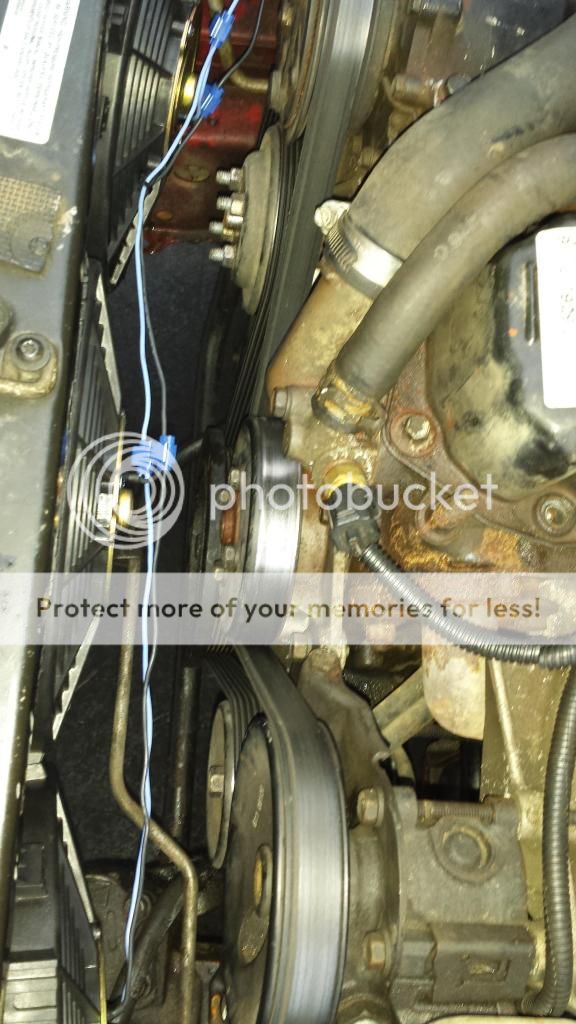shawnhancel
NAXJA Forum User
- Location
- Hubbard, OH
After years of trolling the  community Im happy to finally contribute. I recently pulled the front of the jeep to check my timing chain. Figured this is the best time to remove that HP robbing mechanical fan. My buddy has a wrangler and he suggested I use his fan, which was way too big. After some looking around on summit.com, one of my go to's for aftermarket parts as they're 45 minutes away, found a 10 inch fan rated at 1000 cfm. Needed a controller, well flex-a-lite does a 3 fan kit for big $. I used their controller. Its cheaper at summit. So, altogether 3 fans for 3,000 CFM. The controller has a manual control for adjusting the temp for the on control. I didn't do as good a job as I could of, but Im dropping a aluminum radiator in this summer. Then I will only use 2 fans as I feel they'll provide plenty of cooling. The wires all clear but I still need to wrap them up and protect them a little more, and clean up the bolts from the mechanical fans. Also aside from tapping power from the battery Im going to run a inline fuse from the power distribution block. Sorry if it
community Im happy to finally contribute. I recently pulled the front of the jeep to check my timing chain. Figured this is the best time to remove that HP robbing mechanical fan. My buddy has a wrangler and he suggested I use his fan, which was way too big. After some looking around on summit.com, one of my go to's for aftermarket parts as they're 45 minutes away, found a 10 inch fan rated at 1000 cfm. Needed a controller, well flex-a-lite does a 3 fan kit for big $. I used their controller. Its cheaper at summit. So, altogether 3 fans for 3,000 CFM. The controller has a manual control for adjusting the temp for the on control. I didn't do as good a job as I could of, but Im dropping a aluminum radiator in this summer. Then I will only use 2 fans as I feel they'll provide plenty of cooling. The wires all clear but I still need to wrap them up and protect them a little more, and clean up the bolts from the mechanical fans. Also aside from tapping power from the battery Im going to run a inline fuse from the power distribution block. Sorry if it
Fans are: Proform Electric Fans 67010. $45.97 bucks each (minus 10 if you buy their temp switch and do the rebate)
Fan controller: Flex-A-Lite variable speed controller 33054. $105.97
About 250 bucks with the inline fuses…




 community Im happy to finally contribute. I recently pulled the front of the jeep to check my timing chain. Figured this is the best time to remove that HP robbing mechanical fan. My buddy has a wrangler and he suggested I use his fan, which was way too big. After some looking around on summit.com, one of my go to's for aftermarket parts as they're 45 minutes away, found a 10 inch fan rated at 1000 cfm. Needed a controller, well flex-a-lite does a 3 fan kit for big $. I used their controller. Its cheaper at summit. So, altogether 3 fans for 3,000 CFM. The controller has a manual control for adjusting the temp for the on control. I didn't do as good a job as I could of, but Im dropping a aluminum radiator in this summer. Then I will only use 2 fans as I feel they'll provide plenty of cooling. The wires all clear but I still need to wrap them up and protect them a little more, and clean up the bolts from the mechanical fans. Also aside from tapping power from the battery Im going to run a inline fuse from the power distribution block. Sorry if it
community Im happy to finally contribute. I recently pulled the front of the jeep to check my timing chain. Figured this is the best time to remove that HP robbing mechanical fan. My buddy has a wrangler and he suggested I use his fan, which was way too big. After some looking around on summit.com, one of my go to's for aftermarket parts as they're 45 minutes away, found a 10 inch fan rated at 1000 cfm. Needed a controller, well flex-a-lite does a 3 fan kit for big $. I used their controller. Its cheaper at summit. So, altogether 3 fans for 3,000 CFM. The controller has a manual control for adjusting the temp for the on control. I didn't do as good a job as I could of, but Im dropping a aluminum radiator in this summer. Then I will only use 2 fans as I feel they'll provide plenty of cooling. The wires all clear but I still need to wrap them up and protect them a little more, and clean up the bolts from the mechanical fans. Also aside from tapping power from the battery Im going to run a inline fuse from the power distribution block. Sorry if it Fans are: Proform Electric Fans 67010. $45.97 bucks each (minus 10 if you buy their temp switch and do the rebate)
Fan controller: Flex-A-Lite variable speed controller 33054. $105.97
About 250 bucks with the inline fuses…




